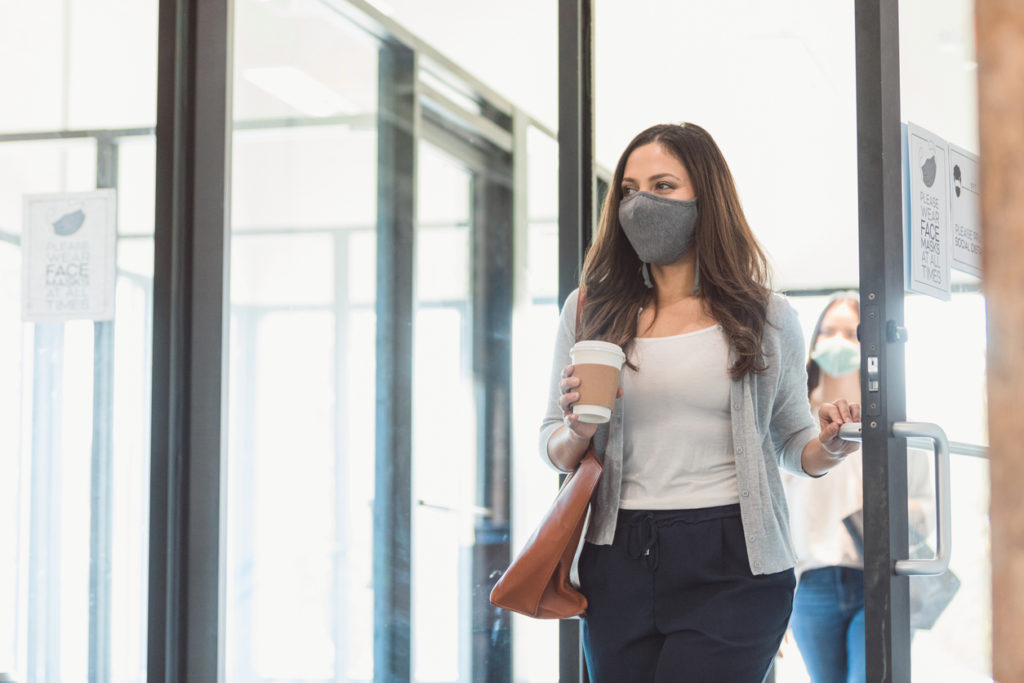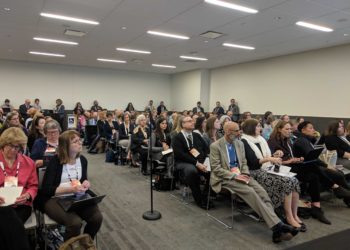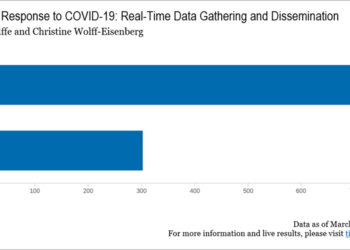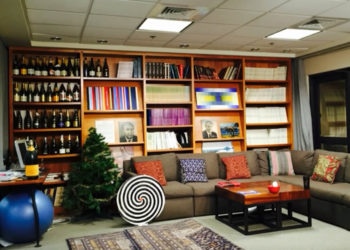With the Omicron surge in the rearview mirror, more companies, including several major scholarly publishers, are working to bring employees back to the office. Navigating a return to the workplace, or avoiding doing so, has proven to be a tricky topic for companies large and small alike. And if you think your organization is facing complexity, well, pity your friends at Facebook, many of whom are returning to the workplace later this month, but shorn of some of their famous perks like on-site laundry and unlimited take-home steak dinners.
Academic libraries, especially at residential institutions, are threading a particularly delicate needle. If students are clamoring for the in-person college experience, institutions are apt to try to provide it, and yet so much information work has seemed feasible to complete virtually. Some institutions are taking a flexible approach to the workplace, hiring employees from outside the region successfully, but many others have adopted a remarkably rigid approach to the return to the workplace. For the latter group, this is at least in part a reflection that colleges and universities typically own their physical plant and so the cost savings they can realize from workplace flexibility are limited and almost zero in the near term.
Other types of employers in our sector are far more likely to lease office space. For them, workplace flexibility has, at least in some cases, more immediate potential for cost-savings. In addition, workplace flexibility has shown benefits of being able to hire from a national employment pool, albeit with commensurate questions about compensation equity in light of cost of living differences. The societal costs, in terms of the likely hollowing out of the commercial centers of many cities, are externalities that employers do not bear directly.
These strategic workforce and financial issues may drive organizational decision-making, but the return to the workplace is ultimately a human issue for all of us, both those of us who cannot bear the isolation of working from home and those of us who have finally found some form of work-life balance. Several Chefs provide their reflections on the return to the workplace below.

Rick Anderson. The Brigham Young University Library never closed during the pandemic. Even when classes were being held entirely or substantially online, the library itself remained open to the campus community. (During peak infection periods we did restrict access to the building, offering services only to BYU students and employees.) We put into place several measures designed to minimize the likelihood of COVID spread: we put a lot of furniture in storage and spread out what remained; we created electronic charts in public areas that were updated in real time to show which areas of the library had the most and which had the fewest people in them; we encouraged all employees who could work from home to do so. And, of course, masks were required inside the building (except for those working in spaces that permitted sufficient social distancing to make masks unnecessary).
Throughout this period, both library and campus administration have been under constant pressure. BYU’s unusual degree of ideological diversity ensured that there would be near-constant outrage from both ends of the political spectrum: those who felt we weren’t doing nearly enough to prevent COVID spread and those who felt that the steps we were taking represented unreasonable overreach. Unsurprisingly, this tension remained unresolved while restrictions were in place; we simply did our best to follow the best science and absorb the outrage from both sides while trying to serve patrons as best we could. Returning to normal business – and as of this writing, we really are back to something very close to the pre-pandemic “normal” – has been challenging in all the predictable ways. Interestingly, our registration went up during the height of the pandemic, in significant part because many young missionaries from the Church of Jesus Christ of Latter-day Saints (BYU’s sponsoring institution) were brought home early all at once, and many of them resumed their college educations. Like many organizations, we found that some of the work done in our library could effectively be done from home, so we have quite a bit more remote work being done now than was true in pre-COVID days. However, BYU has a very strong culture of in-person education, so the great majority of library employees are back onsite full time and classes are pretty much all being taught in person again. As with COVID restrictions, there is disagreement among the campus community as to how quickly these changes should be made, but our continued extremely low case counts since late February (due in part to very high campus vaccination rates) suggest so far that our transition was implemented wisely.
Lisa Janicke Hinchliffe: Academic institutions don’t run on “bankers hours” — classes are scheduled in early mornings, over lunch, and late evenings often six, or even seven days a week. Academic units such as libraries, educational technologies, advising, supplemental learning programs, tutoring, and language labs are also available for long hours. Except for those institutions that are fully online, there is the expectation that these services are available in-person. The Academic Library Response to COVID-19 monitoring project that I conducted with Christine Wolff-Eisenberg in 2020 found that already by October 2020, roughly 1 in 5 libraries had returned to pre-pandemic hours and location access and roughly half of the participating physical library locations were open but with restricted building access and/or limited hours. Though we ceased data collection in fall 2020, all indications are that libraries continued to pivot back to increased hours and access. Library workers have returned to onsite as well and remote work policies contracted from their pandemic-based expansion.
What I have observed, however, is that the way people work has changed. This is in part due to the realities of the unpredictability of school schedules for children or quarantine protocols when there has been a COVID exposure. People are also much more likely to stay home when they are sick, which is from my perspective a very welcome change, and to be more flexible with one another. Many meetings continue to be held on Zoom but with a growing awareness that some things would benefit from in-person gatherings for reasons that are related to strategic priorities, staff cohesion, and/or morale. I will be co-hosting an in-person only “AI Infodemic” reading group this spring and am curious to see how it compares with the online only version we held in 2021.
In sum, then, we are back in the building. We are figuring out how to be back together with each other. When we do gather in-person, a word one hears repeatedly is “joy”… there is a relief and celebration in finding ourselves still, and once again, a community.
Joseph Esposito. With so many people hoping and praying that COVID is now (at least in enlightened areas of the U.S.) behind us, the workplace once again beckons. While policies will be implemented, changed, re-implemented, and changed again, there is one policy that must be avoided, and that is for the leaders of an organization to view remote work as an opportunity to save money. Readers of the business press have already seen this idea developing. Work from home (WFH) potentially means big savings for office space. Why rent 45,000 square feet in midtown Manhattan when you can reduce that footprint to 10,000 square feet and have the staff provide their own work spaces from the convenience of their own homes? Oh, yes, we will reimburse you for a faster Internet connection.
The answer to this is that it is unfair. There are many, many excellent reasons for WFH and hybrid working solutions, but having employees shoulder the cost of their workspaces discriminates against people lower down on the pay scale or with personal living situations that complicate getting any work done — or of having a personal life at all. It may be possible to convert an attic closet into a purely ventilated office, but to what avail if there are three screaming kids with a nanny two floors below? What of the young people who share an apartment with three or four others, who participate in Zoom sessions while sitting on their bed?
Remote options have to come with remote resources. Consider renting remote spaces (WeWork, etc.) for “WFH” staff. But perhaps the best place to work is a central location, where staff can congregate around the water cooler and place bets on the Yankees game and handicap the Academy Awards. That is what we mean when we invoke “community.”
Todd Carpenter. We’re all excited about the prospect of a return to something akin to “normal” in the pre-pandemic sense. But that new normal won’t be quite the same as it used to be. The pandemic has taught organizations of all sorts that they can operate effectively virtually, in many — although certainly not all — respects.
Most of NISO’s work involves organizing teams of volunteers, who rarely gathered physically for years prior to the pandemic. This hasn’t changed, with even the few meetings that were in-person now entirely online. We also had moved the majority of training programs for the community to virtual format after the Great Recession in 2008, after travel budgets were cut back significantly and never really recovered. Over the years, more and more NISO staff were home-based, so the size of the staff who had an office has shrunk over time. So unlike many organizations, the pandemic is putting a very fine point on the reality we have experienced for years: There really isn’t a reason to have a physical space.
When I stepped into my position, NISO had a very cramped office space, of perhaps 700 square feet (65 m2) in the center of Bethesda, MD, which in 2006 cost NISO some $40,000, or more than $50 per square foot (more than $600 per m2). Over the past 15 years, we have moved twice to find less and less expensive space. Presently, our significantly larger space still costs significantly less than it did, not accounting for the 15 years of price inflation. While this isn’t the largest physical footprint, or budget line item, the question is whether the expense is worth it. Since the majority of NISO’s staff work remotely, I keep returning to the question of whether we really need the space we have. Unfortunately, we signed a multi-year lease in 2019, so we are committed to having the space for the next few years, and with so many other tenants in our building having moved or closed, there’s little chance we can get out of our lease, though we probably would if we could. Because a majority of my own time and that of my team involves working with dispersed teams around the world, there’s little difference in whether we perform this work in an office, from our homes, or as was the case with me pre-pandemic, from some hotel at a conference. Even the remaining elements of office paperwork, such as receiving and paying bills, are predominantly online now.
In many respects our office is simply a large, well-appointed storage unit for old files that predated our move to primarily a digital office. Apart from this storage and being a convening space, which hasn’t really happened in more than two years, the office is simply a change of scenery and an expensive post office box. While I can’t get rid of it for now, I don’t envision forcing people to use it. It will be there whenever it is needed for whomever needs it, until we can exit the lease. I do feel a bit sad about this, and think fondly of times when I worked in a boisterous newsroom, but even that was probably a remnant of a bygone era even back in the 1990s.
An interesting aspect of this question is who should see the savings of maintaining an office infrastructure. It is not as if the requirements of maintaining an office space or office infrastructure go away. In a virtual environment where there is no office, those costs are distributed amongst the various staff members. Each must maintain their own phone, internet connectivity, physical space, office furniture, printer toner, and whatever other office support they require. As we move to an office-less environment, organizations are simply repositioning those costs onto their workers, without compensation. In aggregate, that might save the company a lot of money, but it will cost each individual more in ways that are very much buried for the individual. For those organizations that do fairly compensate the employees for those office expenses, I expect that the lack of economies of scale will actually cost organizations a lot more.
Karin Wulf. I don’t think there is a “return” to the workplace. We have new workplaces.
I’m really struck by the divergence many of us are newly identifying between the kind of work that really can be done remotely or with hybrid arrangements and those that can’t. I think we are learning more about that distinction all the time in relationship to the surges of pandemic, the changing labor market, the traumas of racial violence, war, and so much more. Most of all, I think we’re experiencing a resetting of expectations about what work is and how it relates to our lives holistically. This is certainly my experience in my own worklife, and as I am managing and hiring staff. But it’s also what I hear from my family working in very different frontline and service sectors.
In the sector where I work, at universities and in a research institute and then a special collections library, the big change is in the calculus of what we need physical space to do for us. In the library, for example, we have to care for our collection. Those books won’t feed themselves! We need space for readers to come and work with our rare materials. We need space for the staff who work directly with those readers and also who themselves work with the materials. So I am in the building every day. But we’re now exploring more aggressively not only what digitizing materials means for having more researchers who are working remotely but what digital objects mean for all kinds of remote work. We have more and ongoing information about how researchers can gather remotely and what opportunities that opens – and forecloses.
So I don’t feel like we are returning to work, but we are continuing to remake our work. The best outcome here is to do that very intentionally but also sustainably. There is no solution or work experimentation anymore that does not carefully accommodate the reality of staff pandemic stress and more appreciation for the place of work in all our lives. That actually makes for better work and a better workplace, in my view.
Angela Cochran. I find it disheartening when I hear CEOs fret about innovation and culture and use these as a reason to make people return to the office. Culture in particular likely needs to be rebuilt after two years of distributed and mostly crisis-responsive work. Mandating people come back to an office building to preserve “culture” is a red flag that the culture wasn’t great to begin with. Coming out of the pandemic is going to require a lot of hard work but is also an opportunity to get the culture right.
Discussion
3 Thoughts on "Returning to the Workplace"
Bravo to the chefs for opening this discussion. What does our new work culture look like is the question. As a remote worker, pre-pandemic I cringe at the thought of going back to trying to follow a conference room full of colleagues while listening in from a mic in the middle of the table. But, the thought of my colleagues not gathering for such meetings and instead staying in their cubes so the remote staff can better see them is sad as well. We’ll have to figure it out. I agree with Angela, it should not be based on life from two years back, it starts, brand new, now.
Thanks for this. I’m very interested to understand more about the reasons for those elements that people feel can only /best be done in person and why. I think some of this is very hard to articulate and perhaps talks to a part of our humanity that we don’t have words for but I still think it’s a good exercise!
After attending an in person conference recently I started creating a list of the elements of in-person that are not possible or much less effective virtually. I’m hoping to form a more robust understanding to inform future decision making.
Lisa mentions reasons like “strategic priorities, staff cohesion, and/or morale.” Could you dig in a little to these comparing experiences online and in-person? I’d be interested to hear other readers experiences too.
There was a great session at Researcher to Reader last month about the workplace, chaired by Alison Mudditt and I believe recordings will be made available soon.
I’m so glad you surfaced this question, and I look forward to hearing from you and others as well. Some of the things I have observed are challenging include professional/ organizational acculturation and development for early career colleagues, as well as team cohesion and strategic (re)alignment, both of which are made particularly complicated when there are new hires, promotions, or restructuring. Put another way, I hypothesize that more experienced colleagues actually need an in person workplace less for themselves, but they value them more because they have seen the benefits themselves. It’s possible that talented managers can virtualize some of these needs effectively, but that’s the pattern I’ve observed across organizations we work with.



